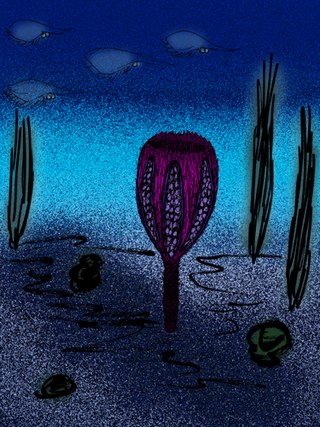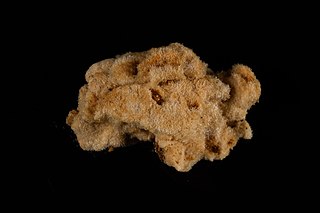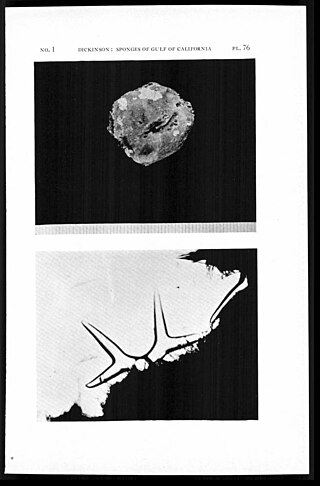
Leucosolenida is an order of sponges in the class Calcarea and the subclass Calcaronea. Species in Leucosolenida are calcareous, with a skeleton composed exclusively of free spicules without calcified non-spicular reinforcements.

Minchinellidae is a family of calcareous sponges, members of the class Calcarea. It is the only family in the monotypic order Lithonida. The families Petrobionidae and Lepidoleuconidae have also sometimes been placed within Lithonida, though more recently they have been moved to the order Baerida. Thanks to their hypercalcified structure, minchinellids have a fossil record reaching as far back as the Jurassic Period.

Hexasterophora are a subclass of glass sponges in the class Hexactinellida. Most living hexasterophorans can be divided into three orders: Lyssacinosida, Lychniscosida, and Sceptrulophora. Like other glass sponges, hexasterophorans have skeletons composed of overlapping six-rayed spicules. In addition, they can be characterized by the presence of hexasters, a type of microsclere with six rays unfurling into multi-branched structures.

Lyssacinosida is an order of glass sponges (Hexactinellida) belonging to the subclass Hexasterophora. These sponges can be recognized by their parenchymal spicules usually being unconnected, unlike in other sponges in the subclass where the spicules form a more or less tightly connected skeleton. Lyssacine sponges have existed since the Upper Ordovician, and three families are still alive today. The Venus' flower basket is one of the most well-known and culturally significant of the glass sponges.

Spicules are structural elements found in most sponges. The meshing of many spicules serves as the sponge's skeleton and thus it provides structural support and potentially defense against predators.

Potamolepidae is a family of freshwater sponges, with seven genera:
Heteractinida is an extinct grade of Paleozoic (Cambrian–Permian) sponges, sometimes used as a class or order. They are most commonly considered paraphyletic with respect to Calcarea, though some studies instead argue that they are paraphyletic relative to Hexactinellida. Heteractinids can be distinguished by their six-pronged (snowflake-shaped) spicules, whose symmetry historically suggested a relationship with the triradial calcarean sponges.

Staurocalyptus is a genus of sponge. It was circumscribed in 1897 by Isao Ijima.

Eiffeliidae is an extinct family of sponges.

Leuclathrina is a genus of sponges belonging to the family Dendyidae. Species are found in the northeast Atlantic and in the Indian Ocean.

Leucettusa is a genus of sponges belonging to the family Leucaltidae. The species of this genus are mostly known from the Arctic and Antarctic, New Zealand and Southwest Australia.
Acanthochaetetidae is a family of sponges belonging to the order Clionaida. It is largely extinct, but contains two extant genera, each of which are represented by single extant species.

Coelosphaeridae is a family of sponges belonging to the order Poecilosclerida. Species are found across the globe.
Lychniscosida is an order of sponges belonging to the class Hexactinellida and subclass Hexasterophora. They are dictyonal sponges characterized by the presence of additional struts at the nodes of the skeleton. These struts create octahedral frames, known as lychniscs ("lanterns").
Calcifibrospongiidae is a family of sponges belonging to the order Haplosclerida. The order Haplosclerida is distinguished by isodictyal skeleton. In general, Porifera are basal animals with bodies full of pores and channels. Calcifibrospongiidae includes the species Calcifibrospongia actinostromarioides. There have only been ten recorded occurrences of this species: in Hogsty Reef and San Salvador, as well as in the subtropics of the Bahamas.
Diapleuridae is a family of glass sponges in the order Lychniscosida. The only living species, Scleroplegma lanterna, is endemic to the waters around Cuba and St. Croix in the Caribbean Sea.
Ectyonopsis is a genus of demosponges in the family Myxillidae. They are mostly known from the waters surrounding Australia and from the Southern Ocean.

Penares is a widely distributed genus of demosponges.

Rosella is a genus of glass sponges in the family Rossellidae. It is found in the Antarctic and sub-Antarctic regions.
Radiocyatha is an extinct group of sponge-like animals which lived in the early to mid-Cambrian Period.












